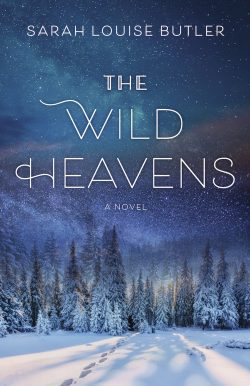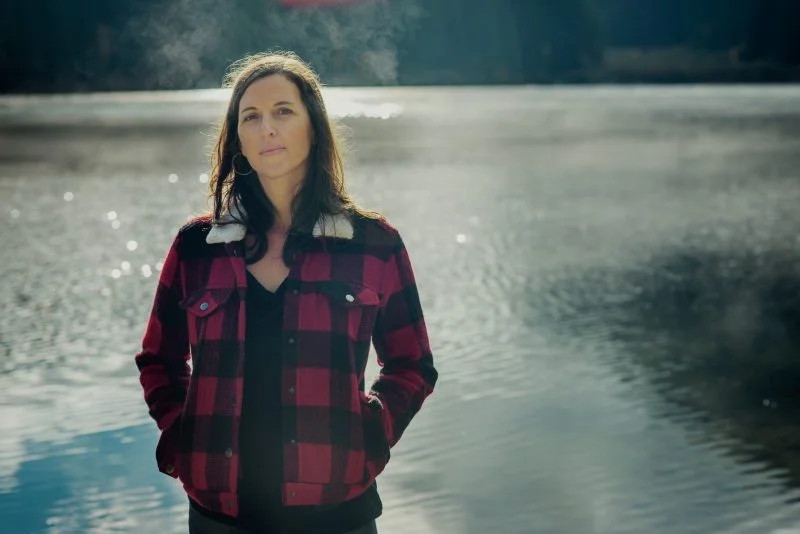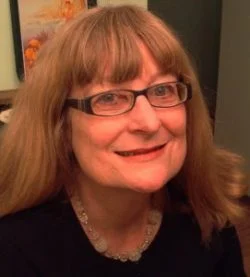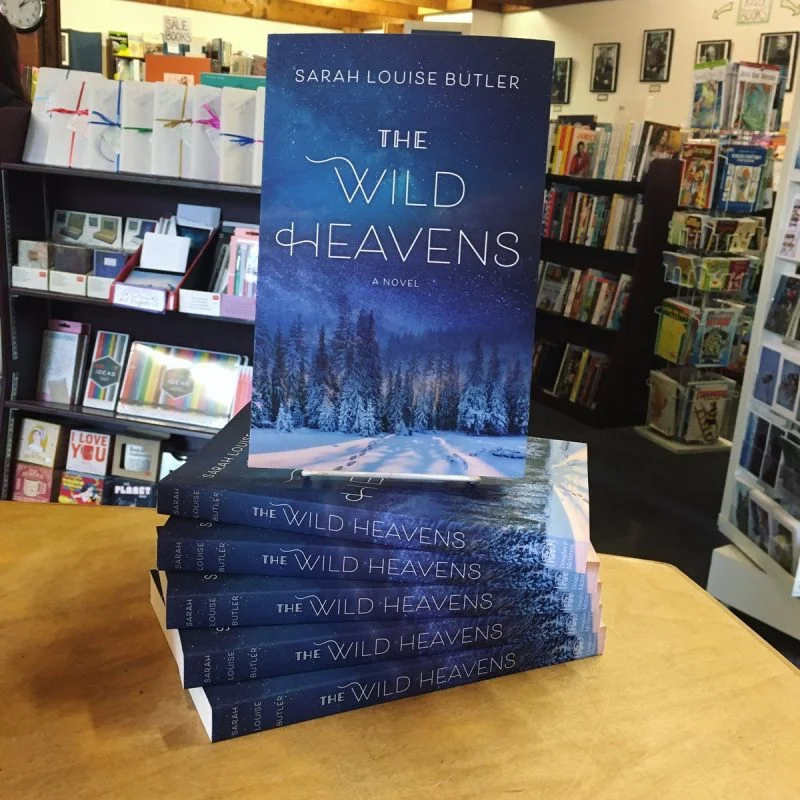#768 A tale of a winter’s day
The Wild Heavens
by Sarah Louise Butler
Madeira Park: Douglas & McIntyre, 2020
$22.95 / 9781771622585
Reviewed by Ginny Ratsoy
*
 From chickadees to lynxes, cedars to lichen, rubber boas to salmon, the other-than human world permeates Sarah Louise Butler’s The Wild Heavens. In this stimulating debut, the natural world is more than a backdrop; it offers survival, companionship, lessons for living an ethical life, and emotional, spiritual, and intellectual sustenance — not to mention challenges to human notions of supremacy. The Wild Heavens is also the latest in a formidable line of novels with strong female protagonists imbedded in the rugged backdrop of the rural BC Interior; perhaps Ethel Wilson’s Swamp Angel (1954) is the model to which writers such as Theresa Kishkan and Gail Anderson-Dargatz (and now Butler) have been drawn.
From chickadees to lynxes, cedars to lichen, rubber boas to salmon, the other-than human world permeates Sarah Louise Butler’s The Wild Heavens. In this stimulating debut, the natural world is more than a backdrop; it offers survival, companionship, lessons for living an ethical life, and emotional, spiritual, and intellectual sustenance — not to mention challenges to human notions of supremacy. The Wild Heavens is also the latest in a formidable line of novels with strong female protagonists imbedded in the rugged backdrop of the rural BC Interior; perhaps Ethel Wilson’s Swamp Angel (1954) is the model to which writers such as Theresa Kishkan and Gail Anderson-Dargatz (and now Butler) have been drawn.
Narrated by Sandy Kingsly over the course of a winter’s day in 2003 in which she renews a search that held her, her grandfather, and her husband in thrall for decades, the story charts her childhood, adolescence, and maturity, illuminating the myriad ways this obsession has shaped her life. Sandy joins the list of transplanted orphaned female protagonists in Canadian literature when the death of her mother in 1959 necessitates her move from Ontario at age seven. Raised by her veterinarian grandfather Aidan Joseph Fitzpatrick — whose seminary studies had been cut short when an encounter with a gigantic, mysterious creature caused him to forsake faith and embrace science — Sandy finds her centre of gravity in the woods. She is in some senses a primitive: home schooled, with her neighbour and peer Luke and his mother Eva (in hiding from an abusive relationship) offering the only other quotidian human companionship, she sees the world largely through the flora and fauna around her. However, hers is not an unsophisticated world; rather, both her grandfather’s erudition and the natural environment stimulate higher-order philosophical thinking and dialogue. Symbiosis, the cultural universality of myths, and the Doctrine of Signatures are not atypical dinner-table topics, with Aidan and Luke often defending science and spirit respectively. Co-existence with the natural world stimulates body, soul, and mind.
This idyllic picture is complicated, both figuratively and literally, by the creature who had earlier caused Aidan’s transformation. Not only does the wooden effigy of Charlie (as Aidan christens it) that the grandfather sculpts grace the front entrance to their cabin, but its spirit also precipitates transformation and tragedy among the characters. Sandy and Luke irrevocably inherit Aidan’s obsession with Charlie when, disobeying her grandfather’s orders not to venture too far up a mountain, she leads Luke to the creature’s den. Although they do not see Charlie, they do disturb the natural order: the stain that unbalances Aidan’s world has now been imprinted on Sandy and Luke. When the two are fourteen, Luke’s father intrudes on the scene, intent on violence toward Eva, and Luke intervenes, necessitating exile for himself and Eva. With adolescence come culpability and disruption.
Sandy becomes more socialized and worldly during Luke’s absence. She attends the high school in town and lifeguards at the local pool, an occupation she likens to bird watching. She also comes to understand the fragility of life — both through her work responsibilities and her complicated appendectomy — which was preceded by a vision of Charlie. On the road to recovery, she learns that Aidan has also seen evidence of Charlie, along with a second set of smaller tracks, and elicited the help of Luke to track them. Charlie proves elusive, and Luke’s stay is short-lived, long enough only to disconcert Sandy and incite their romance.
The resumption of the childhood relationship is initially Edenic. When the two finish high school, Luke returns, they find jobs in town, and the romance solidifies in the cabin. At nineteen, the two wed, significantly, in both a civil ceremony and a natural one — the latter, at the lake, officiated by Aidan. Aidan takes, first, a temporary and then a more permanent teaching job in a northern city. The couple’s first child, Sam, is born and a second child, Lily, is expected. Life in the cabin in the woods seems utopian for the young family.

However, the winter of 1974 puts an end to the idyllic life. Luke again becomes preoccupied by Charlie, after seeing the creature’s tracks at an alarmingly low elevation. Aidan, now elderly, returns to assist Luke in his search. However, the other-than-human proves too much for the pair, and Luke disappears. Ill-advisedly, the pregnant Sandy eventually joins the search for her husband, but finds only his and Charlie’s tracks leading up to a large hole in the ice, but none leading away. Luke’s body is never found; only his backpack provides evidence of his final quest.
The reader receives only scant glimpses into Sandy’s life after Luke. She finds a house in town, befriends her former midwife, becomes a lab technician, and provides a good life for her children. After Aidan’s death, Sandy feels that she has lost not only a surrogate father, but also Charlie, sightings of whom have been scarce in recent years. Sam and Lily, to whom she has confided little about Charlie, leave the area to pursue careers related to the natural world and Sandy’s memories of Luke dim.
The novel’s present time — that single day in 2003 — is as much Sandy’s attempt to recover those memories and, thus, to give shape to her life, as it is to find physical evidence of Luke, or, for that matter, Charlie. Butler wisely keeps Charlie inscrutable. Could Charlie, as Aidan had once mused, “appear differently to different people” and “be both real and mythical”? It is not for Sandy — or the reader — to know the form or gender of the bipedal primate, nor whether there are logical explanations for its apparently supernatural transformative powers.
Drawing from elements of the archetypal quest, the romance, the mystery, and the coming-of-age story, this novel is above all a testament to the interdependence of the human and the more-than-human — and a timely reminder that, if there is a dominant power, it is not us. For the energy of its female-driven journey into (super) natural BC interior spaces, Sarah Louise Butler’s The Wild Heavens deserves a place in the august company of writers such as Wilson, Kishkan, and Anderson-Dargatz .
*

Ginny Ratsoy is an Associate Professor of English at Thompson Rivers University specializing in Canadian literature. Recent courses have included Literature of the BC Interior and The Environment in Canadian Literature. She has published articles on theatre, playwrights, and small cities in British Columbia, and edited books, including Playing the Pacific Province: An Anthology of British Columbia Plays, 1967-2000 (Playwrights Canada Press, 2001, co-edited with James Hoffman); Theatre in British Columbia (Playwrights Canada Press, 2006); and, with W.F. Garrett-Petts and James Hoffman, Whose Culture Is It, Anyway? Community Engagement in Small Cities (New Star Books, 2014). Her latest academic publication is about a wonderful third-age learning organization, The Kamloops Adult Learners Society, in No Straight Lines: Local Leadership and the Path from Government to Government in Small Cities, edited by Terry Kading (University of Calgary Press, 2018), reviewed in The Ormsby Review no. 473 (January 27, 2019).
*
The Ormsby Review. More Books. More Reviews. More Often.
Publisher and Editor: Richard Mackie
The Ormsby Review is a journal service for serious coverage of B.C. books and authors, hosted by Simon Fraser University. The Advisory Board consists of Jean Barman, Robin Fisher, Cole Harris, Wade Davis, Hugh Johnston, Patricia Roy, David Stouck, and Graeme Wynn. Scholarly Patron: SFU Graduate Liberal Studies. Honorary Patron: Yosef Wosk. Provincial Government Patron since September 2018: Creative BC
“Only connect.” – E.M. Forster
